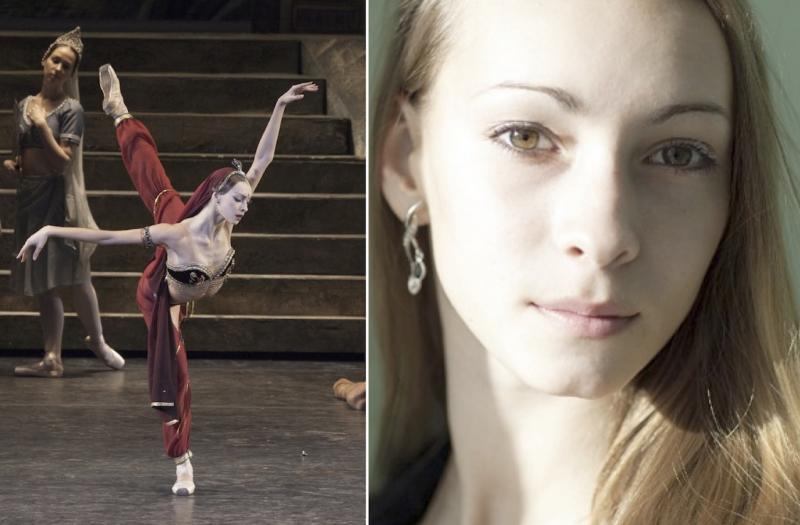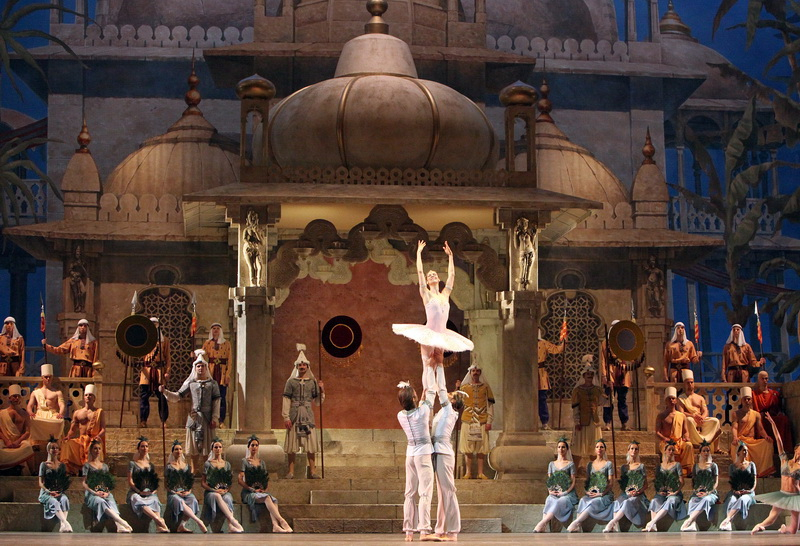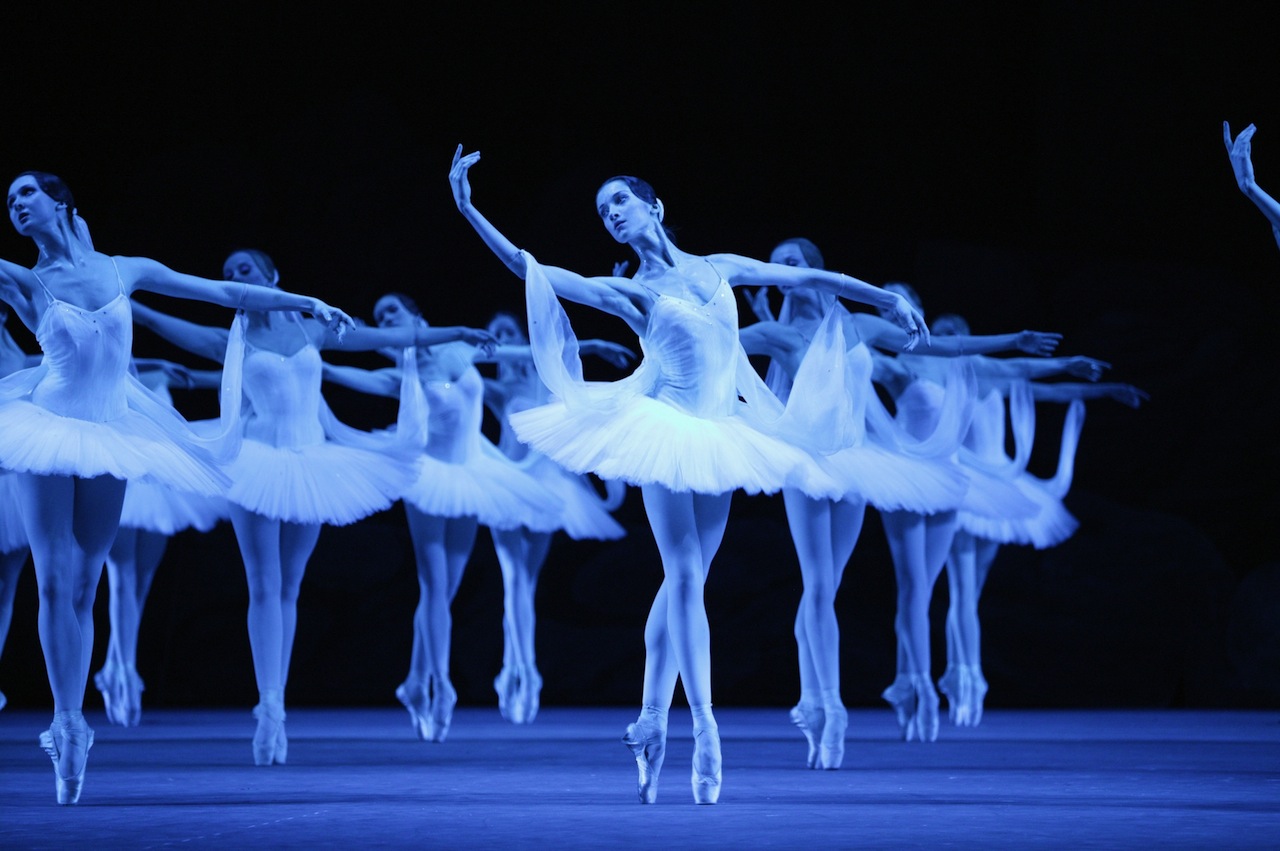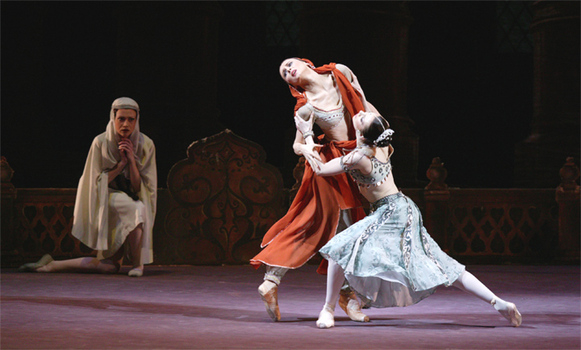La Bayadère, Bolshoi Ballet, Royal Opera House | reviews, news & interviews
La Bayadère, Bolshoi Ballet, Royal Opera House
La Bayadère, Bolshoi Ballet, Royal Opera House
Remember the name - young Olga Smirnova is a ravishing new star

It’s unspeakably bad for so many reasons that the injured Bolshoi Ballet director Sergei Filin cannot be in London to see his company perform, and one is that he can’t see his protegée Olga Smirnova revealing herself to us as destined to be one of the great ballerinas of this era.
In La Bayadère last night she showed herself not only to possess as if by nature all the refinements of classical training, but also as a woman born to make music and tell stories as she dances. There are no frozen arabesques in Smirnova’s being: she spins a constant filament of silk where she goes, she fills tiny micro-pauses with suspense, uses the electricity in her fingers and a proud in-breath to accentuate the climax of a phrase. I don’t think she tries to be an actress, any more than she tries consciously to be musical - she just is. It is no handicap that she is extraordinary beautiful, dark and soulful in last night’s Indian setting as Nikiya, the temple dancer doomed by her caste to be betrayed and murdered.
Former Bolshoi supremo Yuri Grigorovich has interfered less with La Bayadère than he did with Swan Lake, leaving the glorious third act, the “Kingdom of the Shades”, aesthetically intact. New designs by Nikolai Sharonov based on the 1877 originals are half Stonehenge, half Xanadu, and provide a speleologically unlikely arch at the back where in the last notes Nikiya’s ghost stands like a statue, as Solor beats his breast at the front.
 To reach that point, the stage has been home to Indian jungles, jewelled royals, dancers with parrots, gypsy drummers and veiled slavegirls, the action all drawn daggers, poisonous snakes and opium dreams (right, the royal wedding pictured by Damir Yusupov). This ballet was created in 1877 for St Petersburg by Marius Petipa for picaresque entertainment rather than drama - Bollywood meets Swan Lake, you might say - and the king of ballet waltzes, Ludwig Minkus, would no doubt be rather astonished that performers a century or more later would try to read into his jolly tunes the profound secrets of men’s souls. Yet the ballet’s survival all this time is surely because there is, inside its exotic throwaway story, so much potential.
To reach that point, the stage has been home to Indian jungles, jewelled royals, dancers with parrots, gypsy drummers and veiled slavegirls, the action all drawn daggers, poisonous snakes and opium dreams (right, the royal wedding pictured by Damir Yusupov). This ballet was created in 1877 for St Petersburg by Marius Petipa for picaresque entertainment rather than drama - Bollywood meets Swan Lake, you might say - and the king of ballet waltzes, Ludwig Minkus, would no doubt be rather astonished that performers a century or more later would try to read into his jolly tunes the profound secrets of men’s souls. Yet the ballet’s survival all this time is surely because there is, inside its exotic throwaway story, so much potential.
Nikiya, the bayadère, is the holy slave of the High Brahmin, who lusts after her, and she is all too vulnerable to the slick promises of Solor the warrior, who will chuck her when the Rajah offers him a royal marriage. Normal power-sex relations in the Tsar’s court then, but today much more can be shown about all that by fine artists, and Smirnova, slipping on in dread for her opening solo, embodies a plea for pity that’s the more resonant because she is half-resigned. Grigorovich's production has diluted the beseeching dips of the solo, but the young ballerina has (like Altynai Asylmuratova of the Kirov, whom she recalls) the instincts to put that right. Her doomed dance with the flowers that hide the snake that will kill her had a feverish glitter, her supernatural duet with Solor flowed like mist, though there is just an occasional hint of extending her leg higher than she need to.

It would be good to report that Filin’s male protegé, Semyon Chudin, proved equally impressive as Solor, but though he’s exceptionally graceful, he gave little away in dramatic involvement. He cuts high-flying, easily split jetés in his solos, but in this conflicted role a quality of resistance in the dancing can be more telling, to say nothing of more forceful personal presence in the story's telling. He partners Smirnova again in this season in Swan Lake and Diamonds, lyrical roles that may come more naturally to him.
Again, Ekaterina Krysanova, an extremely talented dancer, seemed to be forcing herself to fit Bolshoi emploi as Princess Gamzatti - not quite at ease in the proprietorial bossiness of a royal girl to whom nothing can be denied. The Bolshoi production defines her with a grand entrance as a stock bad aristocrat, which leaves no room for any ambivalence in the character (that’s something the Royal Ballet and Mariinsky productions do allow, adding dramatic value to the violent confrontation between Gamzatti and Nikiya, pictured below left by Yelena Fetisova).
 It’s wretched news that Maria Alexandrova, the wittiest and most glamorous of Russian Gamzattis, injured an Achilles tendon during Friday’s performance and has gone home to Moscow. Alexandrova knows what it is to take pride of place on stage, and will be much missed on this tour (see video below).
It’s wretched news that Maria Alexandrova, the wittiest and most glamorous of Russian Gamzattis, injured an Achilles tendon during Friday’s performance and has gone home to Moscow. Alexandrova knows what it is to take pride of place on stage, and will be much missed on this tour (see video below).
A stodgy High Brahmin from Alexander Fadeyechev looked back to a traditional Bolshoi weakness in mime parts, but Alexei Loparevich’s elegant Rajah, on the other hand, was his own man, and there was, for once, a truly arresting head Fakir leading the unwashed holy men, Anton Savichev, swift and urgent, channelling Spartacus perhaps.
The Golden Idol’s brilliant solo loses context in the three-act version of the story; it is rather overwhelmed by the all-to-frequently capering blacked-up children, but the excellent Igor Tsvirko cut it sharp, high and clean in his gold paint. A note for three gorgeous leading Shades in their Act 3 solos in which Minkus sets demanding tests of control with his teasing pauses and sprints: Anastasia Stashkevich, Daria Khokhlova and Chinara Alizade.
The palace sets are lovely, despite being undermined in space and effect by the curiously domestic-looking paisley front-curtain. Though the Bolshoi orchestra is not spun of such luxury silks as the dancers, and its conductor Pavel Sorokin apparently seemed set on getting the corps de ballet of Shades to their hotel on time rather than in spinning out that dreamy sequence, the evening shows just why La Bayadère remains a top-notch pleasure of ballet theatre. If only it were performed more often.
- The Bolshoi Ballet is at the Royal Opera House till 17 August
Watch Maria Alexandrova and Svetlana Zakharova in the confrontation between Gamzatti and Nikiya in the Bolshoi production
rating
Share this article
Add comment
The future of Arts Journalism
You can stop theartsdesk.com closing!
We urgently need financing to survive. Our fundraising drive has thus far raised £49,000 but we need to reach £100,000 or we will be forced to close. Please contribute here: https://gofund.me/c3f6033d
And if you can forward this information to anyone who might assist, we’d be grateful.

Subscribe to theartsdesk.com
Thank you for continuing to read our work on theartsdesk.com. For unlimited access to every article in its entirety, including our archive of more than 15,000 pieces, we're asking for £5 per month or £40 per year. We feel it's a very good deal, and hope you do too.
To take a subscription now simply click here.
And if you're looking for that extra gift for a friend or family member, why not treat them to a theartsdesk.com gift subscription?
more Dance
 'We are bowled over!' Thank you for your messages of love and support
Much-appreciated words of commendation from readers and the cultural community
'We are bowled over!' Thank you for your messages of love and support
Much-appreciated words of commendation from readers and the cultural community
 R:Evolution, English National Ballet, Sadler's Wells review - a vibrant survey of ballet in four acts
ENB set the bar high with this mixed bill, but they meet its challenges thrillingly
R:Evolution, English National Ballet, Sadler's Wells review - a vibrant survey of ballet in four acts
ENB set the bar high with this mixed bill, but they meet its challenges thrillingly
 Like Water for Chocolate, Royal Ballet review - splendid dancing and sets, but there's too much plot
Christopher Wheeldon's version looks great but is too muddling to connect with fully
Like Water for Chocolate, Royal Ballet review - splendid dancing and sets, but there's too much plot
Christopher Wheeldon's version looks great but is too muddling to connect with fully
 iD-Reloaded, Cirque Éloize, Marlowe Theatre, Canterbury review - attitude, energy and invention
A riotous blend of urban dance music, hip hop and contemporary circus
iD-Reloaded, Cirque Éloize, Marlowe Theatre, Canterbury review - attitude, energy and invention
A riotous blend of urban dance music, hip hop and contemporary circus
 How to be a Dancer in 72,000 Easy Lessons, Teaċ Daṁsa review - a riveting account of a life in dance
Michael Keegan-Dolan's unique hybrid of physical theatre and comic monologue
How to be a Dancer in 72,000 Easy Lessons, Teaċ Daṁsa review - a riveting account of a life in dance
Michael Keegan-Dolan's unique hybrid of physical theatre and comic monologue
 A Single Man, Linbury Theatre review - an anatomy of melancholy, with breaks in the clouds
Ed Watson and Jonathan Goddard are extraordinary in Jonathan Watkins' dance theatre adaptation of Isherwood's novel
A Single Man, Linbury Theatre review - an anatomy of melancholy, with breaks in the clouds
Ed Watson and Jonathan Goddard are extraordinary in Jonathan Watkins' dance theatre adaptation of Isherwood's novel
 Peaky Blinders: The Redemption of Thomas Shelby, Rambert, Sadler's Wells review - exciting dancing, if you can see it
Six TV series reduced to 100 minutes' dance time doesn't quite compute
Peaky Blinders: The Redemption of Thomas Shelby, Rambert, Sadler's Wells review - exciting dancing, if you can see it
Six TV series reduced to 100 minutes' dance time doesn't quite compute
 Giselle, National Ballet of Japan review - return of a classic, refreshed and impeccably danced
First visit by Miyako Yoshida's company leaves you wanting more
Giselle, National Ballet of Japan review - return of a classic, refreshed and impeccably danced
First visit by Miyako Yoshida's company leaves you wanting more
 Quadrophenia, Sadler's Wells review - missed opportunity to give new stage life to a Who classic
The brilliant cast need a tighter score and a stronger narrative
Quadrophenia, Sadler's Wells review - missed opportunity to give new stage life to a Who classic
The brilliant cast need a tighter score and a stronger narrative
 The Midnight Bell, Sadler's Wells review - a first reprise for one of Matthew Bourne's most compelling shows to date
The after-hours lives of the sad and lonely are drawn with compassion, originality and skill
The Midnight Bell, Sadler's Wells review - a first reprise for one of Matthew Bourne's most compelling shows to date
The after-hours lives of the sad and lonely are drawn with compassion, originality and skill
 Ballet to Broadway: Wheeldon Works, Royal Ballet review - the impressive range and reach of Christopher Wheeldon's craft
The title says it: as dancemaker, as creative magnet, the man clearly works his socks off
Ballet to Broadway: Wheeldon Works, Royal Ballet review - the impressive range and reach of Christopher Wheeldon's craft
The title says it: as dancemaker, as creative magnet, the man clearly works his socks off
 The Forsythe Programme, English National Ballet review - brains, beauty and bravura
Once again the veteran choreographer and maverick William Forsythe raises ENB's game
The Forsythe Programme, English National Ballet review - brains, beauty and bravura
Once again the veteran choreographer and maverick William Forsythe raises ENB's game

Comments
Your review is one more proof